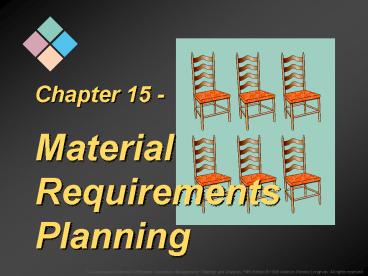Chapter 15 Material Requirements Planning - PowerPoint PPT Presentation
1 / 42
Title:
Chapter 15 Material Requirements Planning
Description:
b. Time periods are usually measured in weeks, although they may be measured in ... Without a new order in Week 4, there will be a shortage of three units: 117 0 ... – PowerPoint PPT presentation
Number of Views:82
Avg rating:3.0/5.0
Title: Chapter 15 Material Requirements Planning
1
Chapter 15 -Material Requirements Planning
2
Demand Patterns
2000 1500 1000 500 0
(a)
(b)
3
What went wrong when EOQ is used to manage a
dependent demand item?
- Incorrect assumption of uniform. continuous
demand - Incorrect assumption on item independence
- Lack of Forward visibility
4
MRP Success
- American Sterilizer Company
- On-time deliveries up from 70 to 95
- Overtime down by at least 50
- Component shortage down by over 80
- Indirect labor down by 24
- Direct labor down by 7
- Survey of Other Firms
- Inventory turns up from 3.2 to 4.3
- On-time delivery up from 61 to 76
- Delivery lead time down from 71 to 59 days
5
Material Requirements Plan Input/Output
Figure 15.2
6
Bill of Materials (BOM)
7
Bill of Materials
Back slats
Seat cushion
Seat-frame boards
Leg supports
Front legs
Back legs
A Ladder-back chair
Figure 15.3
8
Master Production Schedule (MPS)
A detailed plan that states how many end items
will be produced within specified periods of
time. a. End items are either finished products
or the highest level assemblies from which
shippable products are built. b. Time periods
are usually measured in weeks, although they
may be measured in hours, days, or even months.
9
Master Production Schedule
April
May
1
2
3
4
5
6
7
8
Ladder-back chair
150
150
Kitchen chair
120
120
Desk chair
200
200
200
200
Aggregate
670
production plan
670
for chair family
Figure 15.4
10
Inventory Record
Figure 15.5
11
Projected On-hand Inventory
- It I t-1 SRt PRt - GRt
- where
- It projected on-hand inventory at end of week t
- SRt scheduled receipt due in week t
- PRt planned order receipt in week t
- GRt gross requirements in week t
12
Inventory Record
Figure 15.5
13
Planned Orders
Figure 15.6
14
Planned Orders
Figure 15.6
15
Planned Orders
Figure 15.6
16
Planned Orders
Figure 15.6
17
Planned Orders
Figure 15.6
18
Lot-Sizing Rules
- a. Static Lot-Sizing Rules
- Same order quantity each time
- Fixed order quantity (FOQ)
- Interger multiples
- b. Dynamic Lot-Sizing Rules
- Enough to cover a specified number of weeks
- Periodic order quantity (POQ)
- Lot for Lot (L4L)
19
Lot-Sizing Rules - POQ
Figure 15.7
(120 0 150) - 117 153 units
117
117
153
20
Lot-Sizing Rules - POQ
Figure 15.7
(120 0) - 0 120 units
117
117
150
150
0
0
0
153
120
153
120
21
Lot-Sizing Rules - L4L
Figure 15.8
( )
L4L lot size
120 - 117 3
0
3
3
22
Lot-Sizing Rule Comparison
- FOQ does not match requirements exactly, it
generates high average inventory because it
creates remnants. - POQ rule reduces average
- on-hand inventory due to a
- better match between order
- quantity and requirements.
- The L4L rule minimizes inventory investment but
increases the number - of orders placed.
23
MRP Outputs
Figure 15.9
24
Bill of Materials
Figure 15.10
25
MRP Explosion
Figure 15.11
26
MRP Explosion
Figure 15.11
27
MRP Explosion
Figure 15.11
28
MRP Explosion
Figure 15.11
29
MRP Explosion
30
MRP Explosion
31
MRP Explosion--Example 2
32
MRP Explosion-Example 2
33
MRP Explosion-Example 2
34
MRP Explosion-Example 2
35
Action Notices
- A computer-generated memo indicating the need to
release a new order or adjust the due date of a
scheduled receipt. - Release New orders
- If planned order release is in the action bucket.
- Adjusting Due Dates
- 1. Arriving too early If subtracting scheduled
receipt from projected on-hand inventory does not
reduce inventory below desired safety stock. - 2. Arriving too late If projected on-hand
balance for week prior to its arrival is not
enough.
36
Action Notices for Chair seat Assembly
37
Capacity Requirements
Figure 15.12
38
Input-Output Report
39
Requirements Planning-the evolution
- MRP generates schedules that meet the materials
needs identified in the MPS - MRP II ties basic MRP with to the companys
financial system allows for what if analysis
(MPS, cash flow, etc.) - ERP enables firms to deal directly with
suppliers to assess their resources availability
(also includes quality, field services,distributio
n, marketing, accounting etc.)
40
Bill of Resources
(b)
Figure 15.14
(a)
41
MRP Implementation Issues
- Four Prerequisites
- 1. Computer Support
- 2. Accurate and Realistic Inputs
- a. MPS
- b. BOMs
- c. Inventory Record
- 3. Management Support
- 4. User Knowledge and Acceptance
42
Distribution Requirements Planning































